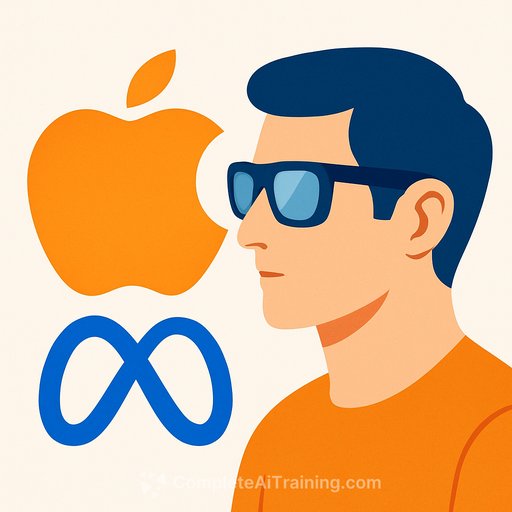Apple Pivots From Cheaper Vision Pro to Smart Glasses: What IT and Dev Teams Should Plan For
Apple has paused its cheaper Vision Pro (code-named N100) and is redirecting teams to smart glasses. The goal: ship two models in time for 2027 - one iPhone-paired with no display (N50) and another with an integrated display. The move follows weak Vision Pro sales driven by weight, price ($3,499), and sparse content.
Apple is still preparing a modest Vision Pro refresh with a faster chip, and earlier tethered glasses (N107) have been shelved. Internally, resources are now focused on accelerating smart glasses development to compete with Meta's strong momentum in this category.
Why the shift
- Vision Pro is too expensive and heavy for mainstream adoption, with limited apps and video content.
- Smart glasses are gaining traction as AI-first, camera-first, voice-driven devices that fit daily use.
- Meta has a multi-year lead with Ray-Ban glasses and is iterating quickly.
What Apple's glasses are expected to do
- N50: pairs with iPhone, no display, heavy reliance on voice and on-device AI.
- Display model: integrated screen to compete with products like Meta's display-equipped glasses, timeline pulled forward.
- Hardware features under exploration: speakers for music, cameras for capture, voice control, health tracking, new chip, multiple styles.
- Software: rebuilt Siri planned as early as March to power new device classes (glasses, speakers, displays, cameras).
How this changes your roadmap (IT and Dev)
- Prioritize voice-first UX. Define clear, short intents, confirmations, and fallbacks. Expect privacy-forward defaults and tight permissions.
- Design for camera-enabled, glanceable interactions. Think capture, summarize, notify, and quick reply - not long sessions.
- Plan an iPhone-companion architecture for N50. Offload heavy compute to the phone; keep on-device inference lightweight.
- Optimize for intermittent attention. Microflows over minutes-long tasks. Latency and reliability are product features.
- Prepare for AI-first affordances: transcription, summarization, image understanding, and context memory - with strict consent flows.
- Enterprise angle: Vision Pro shifts to business use. Pilot training, field service, and remote assistance where ROI is measurable.
Competitive context
- Meta released Ray-Ban Stories in 2021 and hit traction with Ray-Ban Meta in 2023; latest updates improved cameras, battery, and athlete-focused designs.
- New Meta display-equipped glasses are out, with a follow-up planned for 2027 adding a second screen.
- Apple, Meta, and others are also pursuing true AR glasses that blend digital content with reality, beyond simple heads-up overlays.
Timelines and status
- Cheaper Vision Pro (N100): paused.
- N50 iPhone-paired glasses: unveil as soon as next year; release goal in 2027.
- Display glasses: timeline moved up from 2028; Apple is accelerating development.
- Vision Pro: modest refresh with a faster chip targeted as early as end of this year; FCC testing records suggest it's close.
Risks and unknowns
- Apple's voice/AI execution needs to catch up; Siri upgrades are critical to product viability.
- Regulatory and privacy constraints on always-on audio/video will shape the API surface.
- Developer access and SDKs for glasses are unannounced; expect strict permission models and review guidelines.
Practical next steps
- Define voice intents for your core product flows and prototype them on mobile now. Keep prompts and responses short and stateful.
- Ship a capture-to-summary pipeline: photos/video snippets to actionable notes, tasks, or tickets with human-check gates.
- Engineer for low-latency audio and short-session reliability. Budget for on-device inference where possible.
- Harden privacy: explicit opt-ins, redaction, local processing options, and transparent retention controls.
- Pilot enterprise use cases on Vision Pro where it pencils out: procedures, training, remote support.
Resources
- Apple Vision Pro overview
- Meta smart glasses
- Hands-on AI certification for coding (build voice and vision features)
Bottom line: treat smart glasses as a voice-first, camera-enabled extension of the phone. Design micro-interactions, keep compute close to the user, and ship features that work in seconds - not sessions.
Your membership also unlocks:






